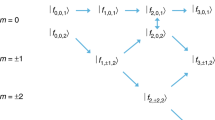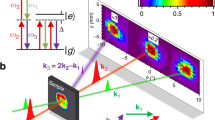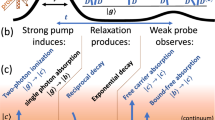Abstract
The absorption of multiple photons when there is no resonant intermediate state is a well-known nonlinear process in atomic vapours, dyes and semiconductors. The N-photon absorption (NPA) rate for donors in semiconductors scales proportionally from hydrogenic atoms in vacuum with the dielectric constant and inversely with the effective mass, factors that carry exponents 6N and 4N, respectively, suggesting that extremely large enhancements are possible. We observed 1PA, 2PA and 3PA in Si:P with a terahertz free-electron laser. The 2PA coefficient for 1s–2s at 4.25 THz was 400,000,000 GM (=4 × 10−42 cm4 s), many orders of magnitude larger than is available in other systems. Such high cross-sections allow us to enter a regime where the NPA cross-section exceeds that of 1PA—that is, when the intensity approaches the binding energy per Bohr radius squared divided by the uncertainty time (only 3.84 MW cm−2 in silicon)—and will enable new kinds of terahertz quantum control.
This is a preview of subscription content, access via your institution
Access options
Access Nature and 54 other Nature Portfolio journals
Get Nature+, our best-value online-access subscription
$29.99 / 30 days
cancel any time
Subscribe to this journal
Receive 12 print issues and online access
$209.00 per year
only $17.42 per issue
Buy this article
- Purchase on Springer Link
- Instant access to full article PDF
Prices may be subject to local taxes which are calculated during checkout




Similar content being viewed by others
References
Gontier, Y. & Trahin, M. On the multiphoton absorption in atomic hydrogen. Phys. Lett. A 36, 463–464 (1971).
Foot, C. J., Couillaud, B., Beausoleil, R. G. & Hänsch, T. W. Continuous-wave two-photon spectroscopy of the 1S–2S transition in hydrogen. Phys. Rev. Lett. 54, 1913–1916 (1985).
Žitnik, M. et al. High resolution multiphoton spectroscopy by a tunable free-electron-laser light. Phys. Rev. Lett. 113, 193201 (2014).
Albota, M. et al. Design of organic molecules with large two-photon absorption cross sections. Science 281, 1653–1656 (1998).
Schneider, H., Maier, T., Liu, H. C., Walther, M. & Koidl, P. Ultrasensitive femtosecond two-photon detector with resonantly enhanced nonlinear absorption. Opt. Lett. 30, 287–289 (2005).
Schneider, H. et al. Terahertz two-photon quantum well infrared photodetector. Opt. Lett. 17, 12279–12284 (2009).
Venkataraman, V., Saha, K., Londero, P. & Gaeta, A. L. Few-photon all-optical modulation in a photonic band-gap fiber. Phys. Rev. Lett. 107, 193902 (2011).
Atanasov, R., Haché, A., Hughes, J. L. P., van Driel, H. M. & Sipe, J. E. Coherent control of photocurrent generation in bulk semiconductors. Phys. Rev. Lett. 76, 1703–1706 (1996).
Hayat, A., Ginzburg, P. & Orenstein, M. Observation of two-photon emission from semiconductors. Nat. Photon. 2, 238–241 (2008).
Stufler, S. et al. Two-photon Rabi oscillations in a single In x Ga1–xAs/GaAs quantum dot. Phys. Rev. B 73, 125304 (2006).
Hendrickson, S. M., Lai, M. M., Pittman, T. B. & Franson, J. D. Observation of two-photon absorption at low power levels using tapered optical fibers in rubidium vapor. Phys. Rev. Lett. 105, 173602 (2010).
Gullans, M. J. & Taylor, J. M. Optical control of donor spin qubits in silicon. Phys. Rev. B 92, 195411 (2015).
Murdin, B. N. et al. Infrared free-electron laser measurement of power limiting by two-photon absorption in InSb. Opt. Quantum Electron. 25, 171–175 (1993).
Ganichev, S. D. et al. Multiphoton absorption in semiconductors at submillimeter wavelengths. Sov. Phys. JETP 64, 729–737 (1986).
Böhm, W., Ettlinger, E. & Prettl, W. Far-infrared two-photon transitions in n-GaAs. Phys. Rev. Lett. 47, 1198–1201 (1981).
Planken, P. C. M. et al. Using far-infrared two-photon excitation to measure the resonant-polaron effect in the Reststrahlen band of GaAs:Si. Opt. Commun. 124, 258–262 (1996).
Zeuner, S., Allen, S. J., Maranowski, K. D. & Gossard, A. C. Photon-assisted tunneling in GaAs/AlGaAs superlattices up to room temperature. Appl. Phys. Lett. 69, 2689–2691 (1996).
Golka, J. & Mostowski, J. Two-photon spectroscopy of shallow donor states in semiconductors. Phys. Rev. B 18, 2755–2760 (1978).
Bassani, F. & Quattropani, A. Two-photon spectroscopy of shallow centers in semiconductors. Solid State Commun. 53, 1077–1081 (1985).
Bassani, F., Forney, J.-J. & Quattropani, A. Choice of gauge in two-photon transitions: 1s−2s transition in atomic hydrogen. Phys. Rev. Lett. 39, 1070–1073 (1977).
Thayyullathil, R. B., Radhakrishnan, R. & Seema, M. Three-photon transitions from ground state to bound states in atomic hydrogen. J. Phys. A 36, 8473–8478 (2003).
Kohn, W. & Luttinger, J. M. Theory of donor states in silicon. Phys. Rev. 98, 915–922 (1955).
Pajot, B. in Optical Absorption of Impurities and Defects in Semiconducting Crystals: Hydrogen-like Centres (eds Cardona, M et al.) Ch. 6 (Springer: Berlin, 2009). .
Murdin, B. N. et al. Si:P as a laboratory analogue for hydrogen on high magnetic field white dwarf stars. Nat. Commun. 4, 1469 (2013).
Clauws, P., Broeckx, J., Rotsaert, E. & Vennik, J. Oscillator strengths of shallow impurity spectra in germanium and silicon. Phys. Rev. B 38, 12377–12382 (1988).
Chang, Y. C., McGill, T. C. & Smith, D. L. Model Hamiltonian of donors in indirect-gap materials. Phys. Rev. B 23, 4169–4182 (1981).
Sauer, R. Optical determination of highly excited s-like donor states in silicon. J. Luminesc. 12, 495–499 (1976).
Greenland, P. T. et al. Coherent control of Rydberg states in silicon. Nature 465, 1057–1061 (2010).
Karaiskaj, D., Stotz, J. A. H., Meyer, T., Thewalt, M. L. W. & Cardona, M. Impurity absorption spectroscopy in 28Si: the importance of inhomogeneous isotope broadening. Phys. Rev. Lett. 90, 186402 (2003).
Ganichev, S. D., Prettl, W. & Huggard, P. G. Phonon assisted tunnel ionization of deep impurities in the electric field of far-infrared radiation. Phys. Rev. Lett. 71, 3882–3885 (1993).
Ganichev, S. D. et al. Carrier tunneling in high-frequency electric fields. Phys. Rev. Lett. 80, 2409–2412 (1998).
Saha, K., Venkataraman, V., Londero, P. & Gaeta, A. L. Enhanced two-photon absorption in a hollow-core photonic-band-gap fiber. Phys. Rev. A 83, 033833 (2011).
So, P. T. C., Dong, C. Y., Masters, B. R. & Berland, K. M. Two-photon excitation fluorescence microscopy. Annu. Rev. Biomed. Eng. 2, 399–429 (2000).
Li, X., van Embden, J., Chon, W. M. J. & Gu, M. Enhanced two-photon absorption of CdS nanocrystal rods. Appl. Phys. Lett. 94, 103117 (2009).
Feng, X., Li, Z., Li, X. & Liu, Y. Giant two-photon absorption in circular graphene quantum dots in infrared region. Sci. Rep. 6, 33260 (2016).
Bristow, A. D., Rotenberg, N. & van Driel, H. M. Two-photon absorption and Kerr coefficients of silicon for 850–2200 nm. Appl. Phys. Lett. 90, 191104 (2007).
Tuncel, E. et al. Free-electron laser studies of direct and indirect two-photon absorption in germanium. Phys. Rev. Lett. 70, 4146–4149 (1993).
Zavriyev, A., Dupont, E., Corkum, P. B., Liu, H. C. & Biglov, Z. Direct autocorrelation measurements of mid-infrared picosecond pulses by quantum-well devices. Opt. Lett. 20, 1886–1888 (1995).
Wang, T. et al. Multi-photon absorption and third-order nonlinearity in silicon at mid-infrared wavelengths. Opt. Express 21, 32192–32198 (2013).
Chick, S. et al. Coherent superpositions of three states for phosphorous donors in silicon prepared using THz radiation. Nat. Commun. 8, 16038 (2017).
Litvinenko, K. L. et al. Weak probe readout of coherent impurity orbital superpositions in silicon. Phys. Rev. B 94, 235207 (2016).
Greenland, P. T. et al. Quantitative analysis of electrically detected Ramsey fringes in P-doped Si. Phys. Rev. B 92, 165310 (2015).
Litvinenko, K. L. et al. Coherent creation and destruction of orbital wavepackets in Si:P with electrical and terahertz read-out. Nat. Commun. 6, 6549 (2015).
Li, L. H. et al. Multi-watt high-power THz frequency quantum cascade lasers. Electron. Lett. 53, 799–800 (2017).
Ohtani, K. et al. High performance 4.7 THz GaAs quantum cascade lasers based on four quantum wells. New J. Phys. 18, 123004 (2016).
Tochitsky, S. Y., Sung, C., Trubnick, S. E., Joshi, C. & Vodopyanov, K. L. High-power tunable, 0.5–3 THz radiation source based on nonlinear difference frequency mixing of CO2 laser lines. J. Opt. Soc. Am. B 24, 2509–2516 (2007).
Knippels, G. M. H. et al. Generation and complete electric-field characterization of intense ultrashort tunable far-infrared laser pulses. Phys. Rev. Lett. 83, 1578 (1999).
Vinh, N. Q. et al. Silicon as a model ion trap: time domain measurements of donor Rydberg states. Proc. Natl Acad. Sci. USA 105, 10649–10653 (2008).
Acknowledgements
The authors acknowledge the Nederlandse Organisatie voor Wetenschappelijk Onderzoek (NWO) for support to the FELIX Laboratory, and financial support from the UK Engineering and Physical Sciences Research Council (COMPASSS/ADDRFSS, grant no. EP/M009564/1). B.N.M. is grateful for a Royal Society Wolfson Research Merit Award. The authors also thank S. Pavlov, M. Thewalt, G. Davies and E. Linfield for useful discussions.
Author information
Authors and Affiliations
Contributions
B.N.M. designed the project. M.A.W.L., N.S., K.S., B.R. and P.T.G. performed the experiments. N.H.L. and B.N.M. provided theoretical methods and calculations. B.N.M., K.L.L., C.R.P. and G.A. wrote the paper.
Corresponding author
Ethics declarations
Competing interests
The authors declare no competing interests.
Additional information
Publisher’s note: Springer Nature remains neutral with regard to jurisdictional claims in published maps and institutional affiliations.
Supplementary information
Supplementary Information
Supplementary Methods, Supplementary Materials.
Rights and permissions
About this article
Cite this article
van Loon, M.A.W., Stavrias, N., Le, N.H. et al. Giant multiphoton absorption for THz resonances in silicon hydrogenic donors. Nature Photon 12, 179–184 (2018). https://doi.org/10.1038/s41566-018-0111-x
Received:
Accepted:
Published:
Issue Date:
DOI: https://doi.org/10.1038/s41566-018-0111-x
This article is cited by
-
EUV-induced hydrogen desorption as a step towards large-scale silicon quantum device patterning
Nature Communications (2024)
-
Giant enhancement of THz-frequency optical nonlinearity by phonon polariton in ionic crystals
Nature Communications (2021)
-
The multi-photon induced Fano effect
Nature Communications (2021)
-
Highly efficient THz four-wave mixing in doped silicon
Light: Science & Applications (2021)
-
Collision-induced amplitude dynamics of fast 2D solitons in saturable nonlinear media with weak nonlinear loss
Nonlinear Dynamics (2021)



